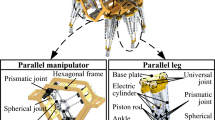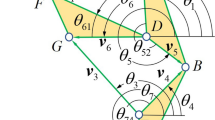Abstract
Multi-legged robot often needs to change its body position and orientation in order to walk over different terrain. A useful position–orientation adjustment algorithm is needed to meet the goal. This paper focuses on position–orientation adjustment algorithm of a six-legged robot which is used to calculate the joint angles when the foothold positions, the center of six-legged robot body and the six-legged robot’s orientation are given. Six-legged robot can move to target position and orientation according to joint angles got by the position–orientation adjustment algorithm. A new approach based on geometry structure is proposed to solve inverse kinematics of the six-legged robot. Furthermore, the inverse kinematics method is used in the position–orientation adjustment algorithm. In addition, a linear tracking simulation is conducted by MATLAB and ADAMS to evaluate the performance of the position–orientation adjustment algorithm, and experiments are done on the six-legged robot to demonstrate the validity of the position–orientation adjustment algorithm.






Similar content being viewed by others
References
Bo J, Cheng C, Wei L, Xiangyun L (2011) Design and configuration of a hexapod walking robot. In: 2011 third international conference on measuring technology and Mechatronics Automation, Shangshai, China, pp 863–866
Burkus E, Odry P (2013) Mechanical and walking optimization of a hexapod robot using PSO. In: 2013 IEEE 9th international conference on computational cybernetics (ICCC), pp 177–180
Chen G, Jin B, Chen Y (2014) Solving position–posture deviation problem of multi-legged walking robots with semi-round rigid feet by closed-loop control. J Central South Univ 21:4133–4141
Craig JJ (2004) Introduction to robotics: mechanics and control. Prentice Hall, London
De Paz JZ, Castaneda EC, Castro XS, Jimenez SR (2013) Crack detection by a climbing robot using image analysis. In: 2013 international conference on electronics, communications and computing (CONIELECOMP), pp 87–91
Erden MS, Leblebicioğlu K (2008) Free gait generation with reinforcement learning for a six-legged robot. Robot Auton Syst 56:199–212
Guardabrazo TA, Jimenez MA, Gonzalez De Santos P (2006) Analysing and solving body misplacement problems in walking robots with round rigid feet. Robot Auton Syst 54:256–264
Ho T, Kang CG, Lee S (2012) Efficient closed-form solution of inverse kinematics for a specific six-DOF arm. Int J Control Autom Syst 10:567–573
Inagaki S, Yuasa H, Arai T (2003) CPG model for autonomous decentralized multi-legged robot system-generation and transition of oscillation patterns and dynamics of oscillators. Robot Auton Syst 44:171–179
Inagaki S, Yuasa H, Suzuki T, Arai T (2006) Wave CPG model for autonomous decentralized multi-legged robot: gait generation and walking speed control. Robot Auton Syst 54:118–126
Kecskés I, Burkus E, Odry P (2014) Swarm-based optimizations in hexapod robot walking. In: 2014 IEEE 9th international symposium on applied computational intelligence and informatics (SACI), pp 123–127
Klaassen B, Linnemann R, Spenneberg D, Kirchner F (2002) Biomimetic walking robot SCORPION: control and modeling. Robot Auton Syst 41:69–76
Manocha D, Canny JF (1994) Efficient inverse kinematics for general 6R manipulators. IEEE Trans Robot Autom 10:648–657
Roy SS, Pratihar DK (2013) Dynamic modeling, stability and energy consumption analysis of a realistic six-legged walking robot. Robot Comput Integr Manuf 29:400–416
Roy SS, Singh AK, Pratihar DK (2011) Estimation of optimal feet forces and joint torques for on-line control of six-legged robot. Robot Comput Integr Manuf 27:910–917
Sandoval-Castro XY, Garcia-Murillo M, Perez-Resendiz LA, Castillo-Castañeda E (2013) Kinematics of Hex-Piderix—a six-legged robot-using screw theory. Int J Adv Rob Syst 10:1–8
Titterton D, Weston J, Titterton DH, Weston JL (2004) Strapdown inertial navigation technology. Institution of Electrical Engineers, UK
Zhang P, Lü T, Song L (2005) RBF networks-based inverse kinematics of 6R manipulator. Int J Adv Manuf Technol 26:144–147
Zhang P, Mu X, Ma Z, Du F (2012) An adaptive PSO-based method for inverse kinematics analysis of serial manipulator. In: 2012 international conference on quality, reliability, risk, maintenance, and safety engineering, Chengdu, China, pp 1122–1126
Acknowledgments
This work is supported by National Natural Science Foundation of China (No. 41506116) and China Postdoctoral Science Foundation (No. 2016M591991), and partly supported by the Science Fund for Creative Research Groups of National Natural Science Foundation of China (No. 51221004).
Author information
Authors and Affiliations
Corresponding author
Rights and permissions
About this article
Cite this article
Chen, G., Jin, B. & Chen, Y. Inverse Kinematics Solution for Position–Orientation Adjustment Algorithm of Six-Legged Robot Based on Geometry Structure. Iran. J. Sci. Technol. Trans. Mech. Eng. 40, 131–137 (2016). https://doi.org/10.1007/s40997-016-0015-7
Received:
Accepted:
Published:
Issue Date:
DOI: https://doi.org/10.1007/s40997-016-0015-7




